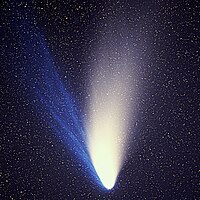Comet Hale–Bopp
Comet Hale–Bopp (formally designatit C/1995 O1) wis aiblins the maist widely observed comet o the 20t century an ane o the brichtest seen for mony decades. It wis visible tae the naked ee for a record 18 months, twice as lang as the previous record haulder, the Great Comet o 1811.
 | |
| Diskivery | |
|---|---|
| Diskivert bi | Alan Hale / Thomas Bopp |
| Diskivery date | Julie 23, 1995 |
| Alternative designations | The Great Comet o 1997, C/1995 O1 |
| Orbital characteristics A | |
| Epoch | 2450460.5 |
| Aphelion | 370.8 AU[1] |
| Perihelion | 0.914 AU[1] |
| Semi-major axis | 186 AU |
| Eccentricity | 0.995086 |
| Orbital period | 2520[2]–2533[1] yr (Barycentric 2391 yr)[3] |
| Inclination | 89.4° |
| Last perihelion | Aprile 1, 1997[1] |
| Next perihelion | ~4385[4] |
Hale–Bopp wis discovered on Julie 23, 1995, at a great distance frae the Sun, raisin expectations that the comet would brichten considerably bi the time it passed close tae Yird. Altho predictin the brichtness o comets wi ony degree o accuracy is very difficult, Hale–Bopp met or exceedit maist predictions when it passed perihelion on Aprile 1, 1997. The comet wis dubbed the Great Comet o 1997.
References
eedit- ↑ a b c d "JPL Small-Body Database Browser: C/1995 O1 (Hale–Bopp)". 2007-10-22 last obs. Retrieved 2008-12-05. Check date values in:
|date=(help) - ↑ Syuichi Nakano (12 Februar 2008). "OAA computing section circular NK 1553". OAA Computing and Minor Planet Sections. Retrieved 17 December 2009.
- ↑ Horizons output. "Barycentric Osculating Orbital Elements for Comet C/1995 O1 (Hale-Bopp)". Retrieved 31 Januar 2011. (Solution using the Solar System Barycenter and barycentric coordinates. Select Ephemeris Type:Elements and Center:@0)
- ↑ "Solex 10 estimate for Next Perihelion of C/1995 O1 (Hale-Bopp)". Archived frae the original on 10 August 2012. Retrieved 18 December 2009.